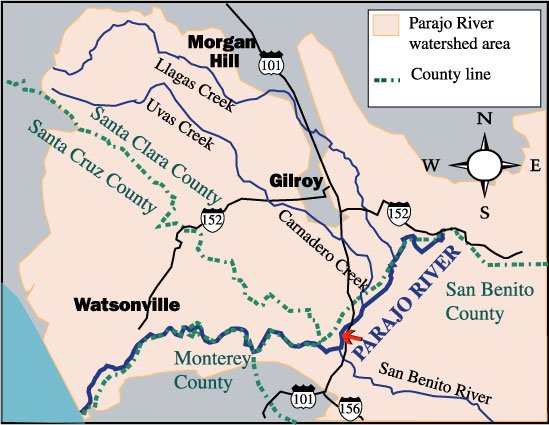HOLLISTER
– San Benito and Santa Clara county officials blocked a proposal
by Monterey and Santa Cruz counties that would have forced local
residents to pay for the levee system in Santa Cruz County.
HOLLISTER – San Benito and Santa Clara county officials blocked a proposal by Monterey and Santa Cruz counties that would have forced local residents to pay for the levee system in Santa Cruz County.
In a meeting of the Pajaro River Watershed Flood Protection Authority, Monterey and Santa Cruz county officials suggested the state should charge San Benito County and a portion of Santa Clara County to help maintain levees along the lower Pajaro River.
But with a 4-4 vote, the proposal to amend a letter to the state’s Department of Water Resources didn’t pass.
San Benito and Santa Clara officials said the letter, if changed, could make it appear their counties were partially responsible for the 1998 floods that overflowed the levees and washed out portions of Pajaro, Watsonville and the Moss Landing area.
During Friday’s meeting of the flood protection authority, officials from San Benito and Santa Clara counties objected to the proposed change in the letter to the DWR because it opened the door for the two counties to be taxed by the state to pay for the care and maintenance of the levees in Santa Cruz County.
Local officials said Santa Cruz and Monterey county officials incorrectly assumed that development in San Benito and southern Santa Clara counties from the late 1980s to the mid 1990s contributed to an increase in the flow of water in the Pajaro River during the 1998 floods.
“An independent consultant, hired by the Flood Protection Authority, examined the water flow and his report said the upstream counties (San Benito and Santa Clara) had no significant impact on water flow,” San Benito County Supervisor Richard Scagliotti said at a previous meeting.
Santa Cruz County Supervisor Tony Campos said despite the way that it may appear to some people, Santa Cruz County was not trying to force San Benito or Santa Clara to pay for the maintenance of the levees.
“I’m not looking at San Benito County and Santa Clara County to raise a bunch of money and giving it to us to fix our river,” Campos said. “It’s not a question of raising $500,000 and handing it over to Santa Cruz County to put in the river. That wouldn’t be fair.”
But Campos said a tax on San Benito and Santa Clara Counties could help them raise money to pay for their flood prevention projects.
“The primary concern is whether San Benito and Santa Clara counties have a direct benefit from us because of all the water going into the drainage ditch,” Campos said. “Maybe there is less water going in the river now than there was in 1947, but in 1947 the river was designed to go to a 30-year life, but now we have less than a seven-year life.”
The levees have become an issue recently as Santa Cruz County has become strapped for funds during continuing state budget problems. Santa Cruz can not afford to maintain the levees and officials are proposing to abandon their previous obligation to maintain the levees, Santa Cruz County Public Information Officer Diana Phillips said.
“The county is requesting that the state take back control of the levees,” Phillips said. “It is because of a combination of monetary considerations and conflicting regulations from the Department of Fish and Game.”
The Pajaro River levee system was built in 1949 by the Army Corps of Engineers following a devastating flood in 1947. It was intended to protect communities along the lower Pajaro River from winter flooding.
The levees were supposedly strong enough to survive a 100-year flood – the largest flooding an area experiences every 100 years.
However, within six years of being built, the Pajaro River flooded its banks, causing millions of dollars worth of damage.
Since the levees were built, there have been six separate major flooding events along the Pajaro River and its tributaries, which includes the San Benito River, and several communities are still trying to recover from the floods of 1995 and 1998, Campos said.













